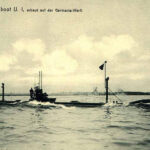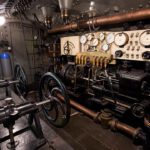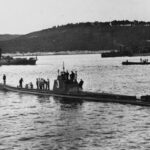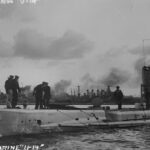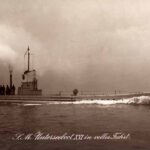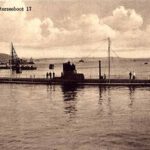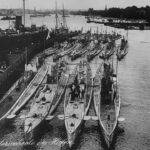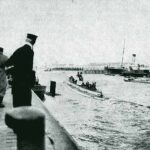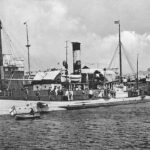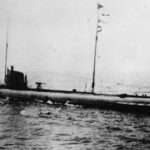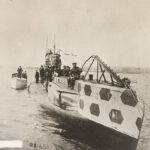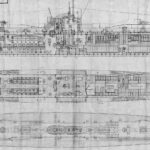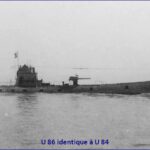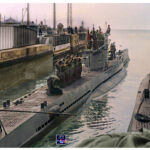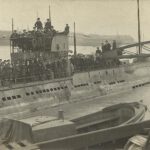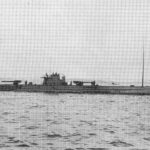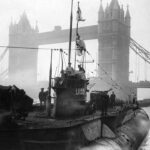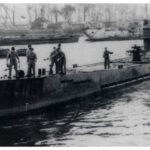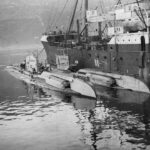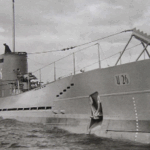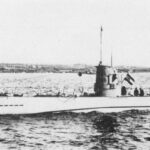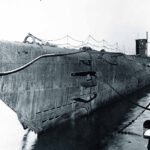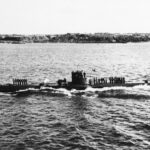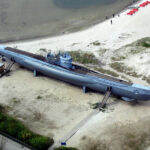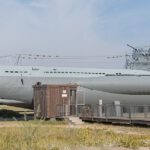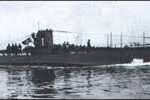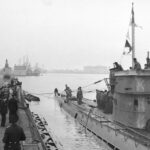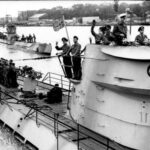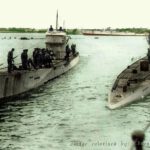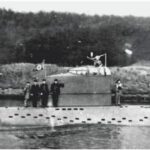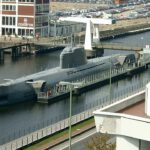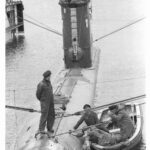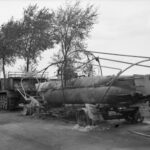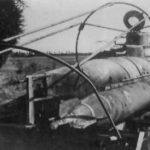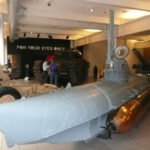
German U-boat history spans from early prototypes in the mid-19th century to their prominent roles in both World Wars, where they were primarily used to sink enemy shipping and disrupt trade routes. They were a major factor in bringing the United States into World War I and posed a severe threat to Allied supply lines in World War II. The history includes early submarine development, the massive but ultimately costly U-boat campaigns, and the eventual surrender of most of the fleet after the
wars.
World War I:
- Early development: Germany’s first submarine, the Brandtaucher, sank in 1851, but the first functional German submarine, the Forelle, was built in 1903.
- Naval integration: The first submarine commissioned by the German Navy was the SM U-1 in 1906, followed by the more advanced SM U-19 in 1912, which featured a more powerful diesel engine.
- Warfare: U-boats achieved significant successes against Allied warships and merchant ships.
- Unrestricted submarine warfare: In 1915, Germany began unrestricted submarine warfare, which was temporarily suspended due to U.S. protests, but resumed in February 1917.
- U.S. entry: The U-boat campaign was a significant factor in the United States entering the war.
- Post-war: The surviving U-boats were surrendered under the Treaty of Versailles, which aimed to prevent Germany from threatening British trade again.
World War II:
- Resumption of service: Germany built 1,162 U-boats for this war.
- “Happy Time”: From mid-1940 to early 1942, U-boats inflicted heavy losses on Allied and neutral shipping, a period known as the “happy time”.
- Strategic goal: The goal was to sever Britain’s supply lines to force it out of the war.
- Shift in balance: The entry of the United States and the subsequent increase in ship production, particularly the Liberty ships, shifted the balance of power against the U-boats.
- Technological advancements: Germany developed advanced U-boat classes like the Type VII and Type IX, which featured improved capabilities like longer range and more effective torpedoes.
- Atlantic U-boat bases: Germany established massive U-boat bases in occupied France, such as those at Lorient and Saint-Nazaire, which gave their submarines a significant advantage in the Atlantic.
- Defeat: By 1943, the U-boats were vulnerable, and by the end of the war, most were destroyed, surrendered, or scuttled.
Post-war:
- Surviving U-boats were taken as war prizes by the Allied powers and served in navies such as those of the United Kingdom, France, and the Soviet Union.
World War I – era
Class | No. build | Commissioned | Notes |
U 1 | 1 | 14-12-1906 | SM U-1 is the first U-boat produced for the German Empire's Imperial German Navy. |
U 2 | 1 | 18-07-1908 | SM U-2 was a vast improvement over her predecessor SM U-1 |
U 3 | 2 | 1909 | Type U 3 subs had more powerfull engines than the previous U 2 and were more reliable. |
U 5 | 4 | 1910 - 1911 | All lost |
U 9 | 4 | 1910 - 1911 | Lost 3 |
U 13 | 3 | 1912 | Lost 3 |
U 16 | 1 | 28-12-1911 | U-16 was a pre-war U-boat, served up to 1915 when she was utilized as a training submarine. |
U 17 | 2 | 1912 | Lost 1 |
U 19 | 4 | 1913 | The first subs with Diesel engines for surface propulsion and charging the batteries. |
U 23 | 4 | 1913 - 1914 | Lost 2 |
U 27 | 4 | 1914 | Lost 3, They were very similar to the preceding Type U 19 and Type U 23. |
U 31 | 12 | 1915 - 1919 | Lost 7, German Type U 31 submarines were double-hulled ocean-going submarines |
U 43 | 7 | 1915 - 1916 | Lost 6, he Type U43 was the continuation of previous double-hull U-boats design |
U 51 | 6 | 1916 | Lost 2 |
U 57 | 12 | 1916 - 1917 | Lost 7 |
U 63 | 3 | 1916 | Lost 2 |
U 66 (UD) | 5 | 1915 | Lost 3, The class is alternately referred to as the U-66 class or the Type UD. |
UE I | 10 | 1915 - 1916 | Lost 7, The UE I submarine were ocean-going single-hull submarines with saddle tanks |
U 81 | 6 | 1916 | Lost 4, Type 81 U-boats carried 12 torpedoes and had various arrangements of deck guns. |
U 87 | 6 | 1917 | Lost 4, Type 87 U-boats carried 16 torpedoes and had various arrangements of deck guns. |
U 93 | 24 | 1917 - 1919 | Lost 6, |
U 115 | 2 | -- | Never completed |
UE II | 10 | 1918 | Lost 6, UE II boats carried 14 torpedoes and were armed with one 150 mm deck gun. |
U 127 | 8 | -- | Never completed |
U 135 | 4 | 1918 | Planned 8, Completed 2, canceled 6 |
U 139 | 3 | 1918 | U-139, originally designated "Project 46", long-range U-boats built during World War I. |
U 142 | 9 | 1918 | It notably served as a template for the Imperial Japanese Navy's "Junsen type submarines". |
U 151 | 7 | 1917 | Type U 151, a class of large, long-range submarines initially constructed as a merchant sub. |
U 158 | 2 | 1918 | The war ended before they could see active service, and they were broken up in 1919. |
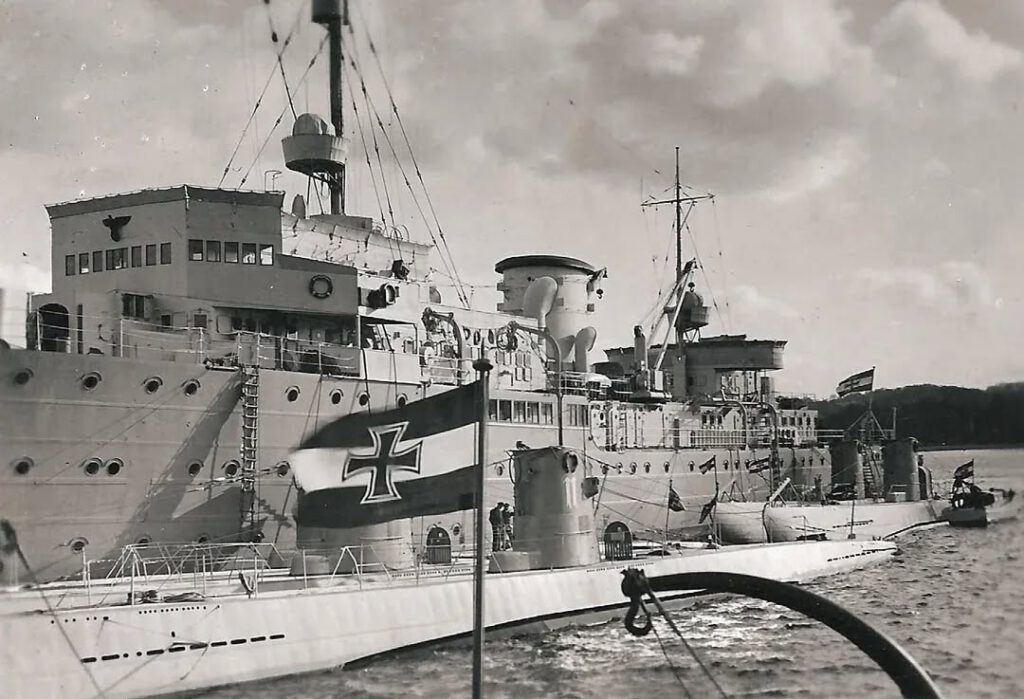
Coastal U-Boats (UB)
Class | No. build | Commissioned | Notes |
UB I | 20 | 1915 | Lost 10, Type UB I was a class of small coastal submarines at the beginning of WW I. |
UB II | 38 | 1915 - 1916 | Lost 21, Type UB II class was twice as large as the preceding type UB I. |
UB III | 96 | 1917 - 1919 | Planned 201, building 145, 96 completed, 56 cancelled, 37 lost |
Coastal Minelaying U-Boats (UC)
Class | No. build | Commissioned | Notes |
UC I | 15 | 1915 | Completed 15, Lost 14, The UC I submarines were a class of small minelaying U-boats. |
UC II | 38 | 1916 - 1917 | Completed 64, lost 47, Significant improvement over the preceding Type UC I |
UC III | 96 | 1917 - 1919 | Planned 113, completed 25, lost 1 |
Foreign U boats (WW I)
U-boat | No. build | Commissioned | Notes |
SM UA | 1 | 14-08-1914 | Ex-Norwegian A-class submarine A-5 |
U-66 - U-70 | 4 | -- | Ex-Austro-Hungarian U-7 class U-7 to U-11 |
US-1 | 1 | -- | Ex-Russian Bars class Burevestnik, only test run - not in service |
US-2 | 1 | -- | Ex-Russian Bars class Orlan, Commissioned later abandoned to White Russian Forces |
US-3 | 1 | -- | Ex-Russian Bars class Utka, only test run - not in service |
US-4 | 1 | -- | Ex-Russian Bars class Gagara, only test run - not in service |
No reliable pictures availebale of the Foreign U-Boats.
World War II U-Boats
Class | No. build | Commissioned | Notes |
Type I | 2 | 1936 | Type I was the first post–WW I attempt to produce an oceangoing sub for Nazi Germany |
Type IIA | 6 | 1934 - 1935 | The Type IIA was a single hull, all welded boat with internal ballast tanks. |
Type IIB | 20 | 1935 - 1940 | The Type IIB was a lengthened version of the Type IIA. |
Type IIC | 8 | 1938 - 1940 | The Type IIC was a further lengthened version of the Type IIB. |
Type IID | 16 | 1940 - 1941 | The Type IID had additional saddle tanks fitted to the sides of the external hull. |
Type VIIA | 10 | 1936 | Type VII was a class of medium attack U-boats built for Nazi Germany from 1935 to 1945. |
Type VIIB | 24 | 1938 - 1940 | The type VIIB is an improved version of the Type I and Type VII U-boats. |
Type VIIC | 581 | 1940 - 1944 | The Type VIIC design was the same of Type VIIB but a extra sonar room was created. |
Tyope VIIC/41 | 125 | 1943 - 1945 | Same as the Type VIIC but an improved performance design |
Type VIID | 6 | 1941 - 1942 | Type VIID were the same as their Type VIIC sisterships, with benefits of extra range. |
Type VIIE | 0 | -- | Type VIIE was a project for trying out lightweight diesel engines. Construction did not start. |
Type VIIF | 4 | 1943 | Type VIIF but was with 1,084 t (1,067 long tons) much heavier. Without loosing much speed. |
Type IXA | 8 | 1938 - 1939 | Type IXA submarines were intended to be fairly large ocean-going submarines. |
Type IXB | 14 | 1939 - 1940 | Thirteen were sunk in the course of the war, the remaining one was decommissioned. |
Type IXC | 54 | 1941 - 1942 | Type IXC had a wider outer hull, with storage for more fuel, increasing the boat's range. |
Tyoe IXC/40 | 87 | 1942 - 1944 | Type IXC/40 was an improved Type IXC with slightly increased range. |
Tyoe IXD | 32 | 1942 - 1944 | The Type IXD was significantly longer and heavier than the IXC/40. |
Tyope X (XB) | 8 | 1941 - 1944 | Originally a long-range minelayer, the Type X were later used as long-range cargo transports. |
Type XI | -- | -- | The Type XI was a planned artillery boat but were cancelled at the outbreak of WWII. |
Type XIV | 17 | 1941 - 1943 | 24 were planned, only 10 were commissioned, 3 were cancelled and 11 never laid down. |
Type XVIIA | 4 | 1943 - 1944 | Type XVII U-boats were small coastal submarines. |
Type XVIIB | 3 | 1944 - 1945 | 12 Type XVIIB submarines were planned, but only three were completed. |
Type XVIIK | 1 | -- | Was still incomplete in May 1945. |
Type XCVIII | 2 | 1944 | Type XVIII was a projected attack boat using the Walter propulsion system. 1 canceled. |
Type XXI | 118 | 1944 - 1945 | Type XXI were a class of diesel–electric submarines, 118 were completed. |
Type XXII | 61 | 1944 - 1945 | Type XXIII were ("electric boats"). They were small coastal submarines. |
Midget submarines
Class | No. build | Commissioned | Notes |
Biber class | 324 | 1944 | |
Molch class | 393 | 1944 | Molch was an unsuccessful series of one-man submarines created during World War II. |
Seehund class | 285 | 1944-1945 | Lost 35, active 138, Seehund also known as Type XXVII, operated by two-man crews. |
Biber class
The Biber (German for “beaver”) was a German midget submarine of the Second World War. Armed with two externally mounted 53-centimetre (21 in) torpedoes or mines, they were intended to attack coastal shipping. They were among the smallest submarines in the Kriegsmarine. The Biber was hastily developed to help meet the threat of an Allied invasion of Europe. This resulted in basic technical flaws that, combined with the inadequate training of their operators, meant they never posed a real threat to Allied shipping, despite 324 submarines being delivered. One of the class’s few successes was the sinking of the cargo ship Alan-A-Dale.
Several survive in museums, including one in operational condition.
